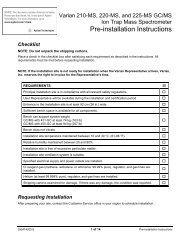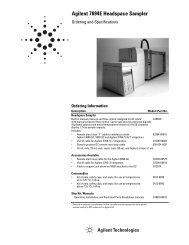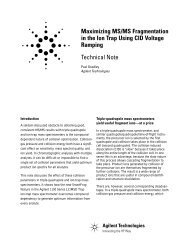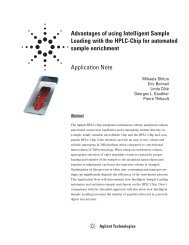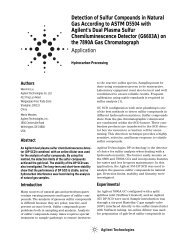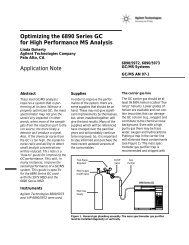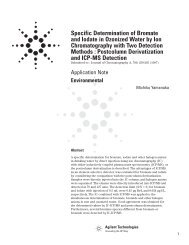Microplate Barcode Labeler User Guide - Agilent Technologies
Microplate Barcode Labeler User Guide - Agilent Technologies
Microplate Barcode Labeler User Guide - Agilent Technologies
You also want an ePaper? Increase the reach of your titles
YUMPU automatically turns print PDFs into web optimized ePapers that Google loves.
36<br />
Chapter 3: Installing the VCode<br />
VCode <strong>User</strong> <strong>Guide</strong><br />
About Ethernet networking<br />
Introduction<br />
There is more than one way to set up an Ethernet network. This topic<br />
provides the information you need to decide which connection method<br />
will work best for you.<br />
For help deciding whether to set up an Ethernet or serial network, see<br />
“Choosing between a serial or Ethernet network” on page 34.<br />
Network<br />
requirements<br />
You can use Ethernet cables to make a stand-alone connection between<br />
the computer and a VCode or to connect the VCode to a dedicated lab<br />
automation local area network.<br />
Both methods require that the controlling computer has an available<br />
network card. Most computers come with one Ethernet network card,<br />
and if you want to use this card to communicate with your lab’s general<br />
network (for email, Internet access, and so on), you will need to install<br />
an additional card to communicate with your VCode.<br />
You will also need one or more Ethernet cables to make the physical<br />
connections. If you plan to connect multiple VCodes you will also need<br />
an Ethernet switch to connect the single Ethernet cable attached to your<br />
computer with the multiple Ethernet cables of the VCodes.<br />
About IP addresses<br />
IP address function<br />
The computer’s network card, and each device on the network, must be<br />
assigned a different number, called an IP address. IP addresses allow<br />
computers and devices to be uniquely identified on a network so that<br />
information can be specifically routed to them.<br />
Ways to assign an IP address<br />
There are two ways to assign an IP address:<br />
❑ Statically, by assigning it manually so that it never changes<br />
❑ Dynamically, by automatically assigning a new address every time<br />
the computer or device is turned on.<br />
Dynamic assignment uses DHCP (Dynamic Host Configuration<br />
Protocol) software.<br />
Network card and<br />
VCode IP addresses<br />
It is important to consider separately the IP address of the computer’s<br />
network card, and the IP addresses of VCode and any other devices on<br />
the network.<br />
Computer’s IP address<br />
The network card of the computer that is controlling the VCode on a<br />
small lab automation network always has a static IP address. This is even<br />
the case when the devices are dynamically assigned addresses, because<br />
of the way that the DHCP server works. When the server starts, it reads<br />
an initialization file that points it to the network card through which the<br />
computer will serve addresses. A screenshot of the initialization file is<br />
shown below.



